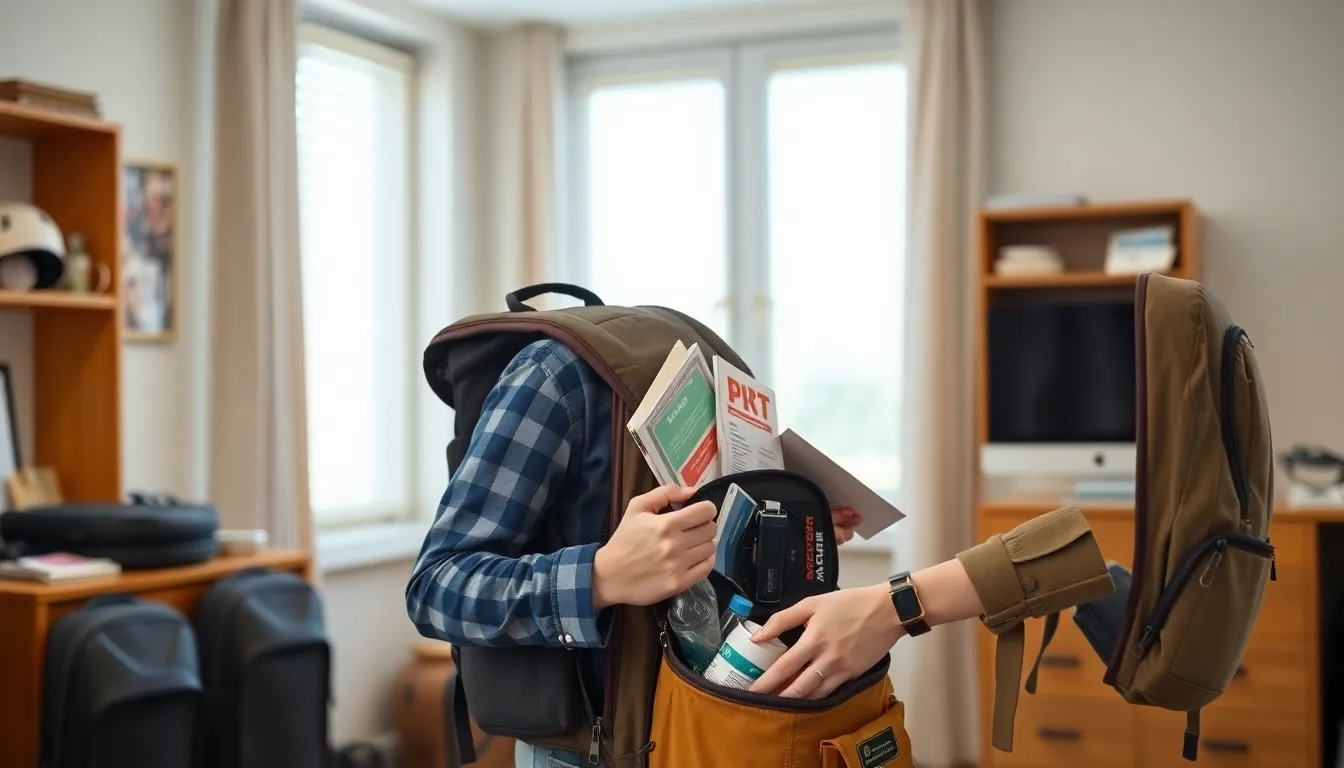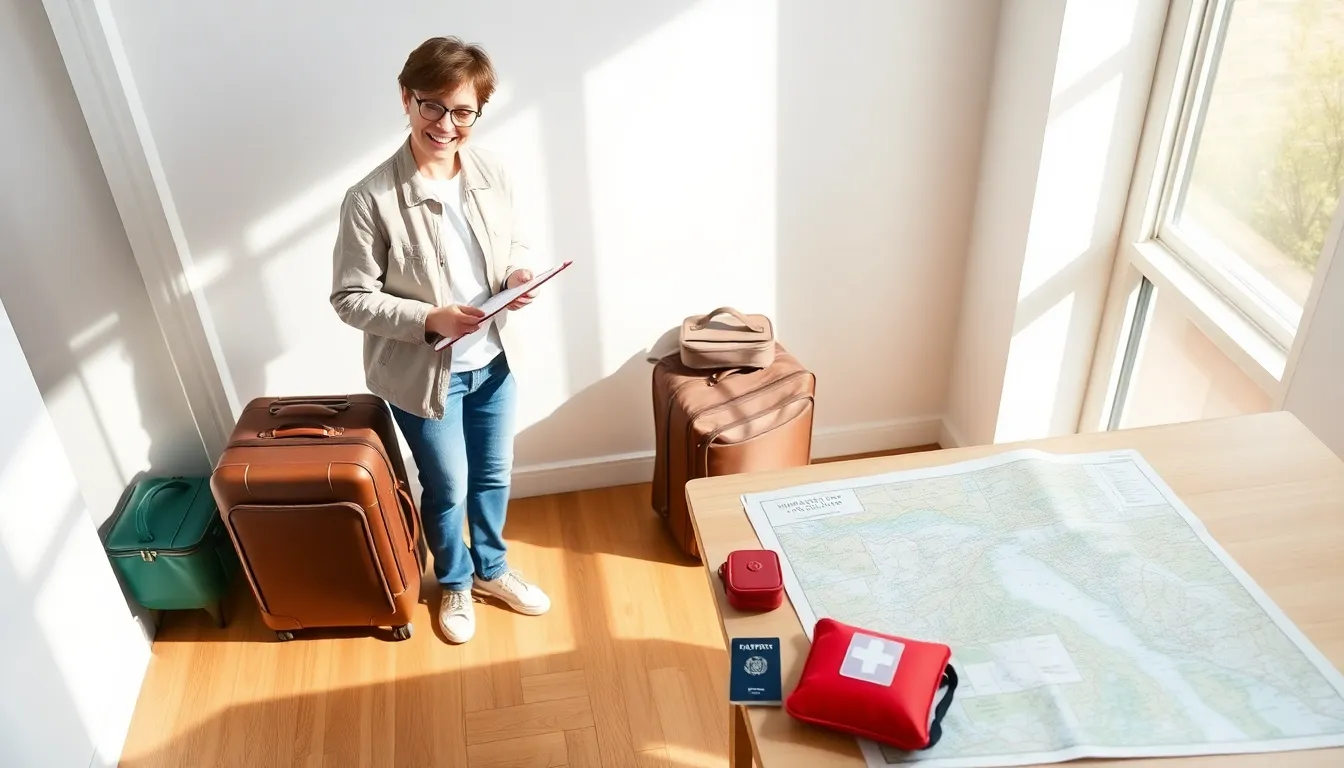Planning a trip can feel like preparing for a mission to Mars. Between packing your bags and securing your passports, it’s easy to forget the essentials that keep you safe. A safety travel checklist isn’t just a helpful tool; it’s your trusty sidekick in the wild world of travel. Think of it as your personal superhero cape that ensures you’re ready for anything, from unexpected weather to pesky travel mishaps.
Table of Contents
ToggleImportance Of A Safety Travel Checklist
A safety travel checklist serves multiple critical roles in trip planning. It ensures travelers do not overlook essential items, reducing potential stress during the journey. Securely packing important documents like passports and tickets becomes easier with a checklist, preventing last-minute scrambles.
Preventing unexpected situations stands as another key benefit. Travelers prepare for various scenarios, from bad weather to medical emergencies. The list offers peace of mind, knowing that there’s a plan in place for the unforeseen.
Organizing travel gear happens more efficiently with this useful tool. By categorizing items, travelers can assess what they possess and what remains to be packed. This organization streamlines the packing process and enhances travel readiness.
Additionally, a checklist increases safety awareness. Travelers remain mindful of safety precautions such as checking weather forecasts and confirming accommodation details. Each step promotes a proactive approach, ensuring a smoother experience.
Ultimately, a safety travel checklist acts as a reliable partner. Maintaining focus on critical tasks enhances overall trip enjoyment. Missing out on vital preparations diminishes travel experiences; thus, adopting a checklist emerges as a smart choice for any traveler.
Essential Items To Include

A comprehensive safety travel checklist ensures travelers pack crucial items for their journey. Paying attention to each category enhances trip preparation.
Documents And Identification
Travelers must carry essential documents like passports, visas, and identification cards. Keeping copies of these documents helps safeguard against loss or theft. Storing digital copies on mobile devices ensures easy access. Travelers should also check the expiration dates of their documents prior to departure. Securely packing these items in a designated pouch simplifies retrieval during travel.
Emergency Contacts
An updated list of emergency contacts is critical for travel safety. This list should include family members, friends, and local emergency service numbers. Travelers can program these contacts into their mobile devices for quick access. Writing down important numbers on paper is wise in case of technology failure. Including contacts for accommodations and local embassies provides additional security. Keeping this list easily accessible can ease stress during unexpected situations.
First Aid Kit
A well-stocked first aid kit is a necessary aspect of travel safety. Essential items include adhesive bandages, antiseptic wipes, and pain relievers. Travelers must customize their kits to meet specific needs, such as allergies or ongoing medications. Including any required prescriptions ensures preparedness for medical situations. Regularly checking and replenishing the kit before each trip keeps supplies up to date. Keeping the kit within reach during travel promotes quick response in emergencies.
Personal Safety Items
Personal safety items enhance security during travel. A whistle, flashlight, and pepper spray are worthwhile additions. Carrying a personal alarm can deter potential threats in unfamiliar areas. Wearing a money belt helps secure valuables while on the go. Privacy screens for mobile devices protect personal information in public settings. Being proactive with personal safety items increases overall travel security.
Tips For Creating Your Own Checklist
Creating a checklist tailored to individual travel needs enhances safety and preparedness for any journey. Travelers benefit from a personalized approach, ensuring every trip receives appropriate attention to detail.
Tailoring To Your Destination
Understanding the destination plays a vital role in crafting a safety checklist. Geographic location affects weather conditions, local customs, and health considerations. For instance, travelers going to tropical regions should include insect repellent and sun protection. In colder climates, packing layers and winter gear becomes essential. Researching local health advisories can prompt the inclusion of necessary vaccinations or medications. Specific cultural practices might suggest additional items, such as clothing that aligns with local norms. By aligning the checklist with the destination’s unique demands, travelers can navigate challenges and enhance safety during their trips.
Regular Updates
Maintaining an updated checklist ensures it remains relevant and effective. Regularly reviewing items incorporates any recent excursions or changing travel regulations. Items such as first aid kits and emergency contact lists benefit from timely updates, reflecting new health information or safety contacts. Frequent updates can also highlight seasonal concerns, such as travel gear for winter versus summer trips. Additionally, incorporating feedback from previous travels can identify neglected items and prevent oversights in future journeys. An updated checklist not only promotes safety but also instills confidence in preparedness, enabling travelers to focus on enjoying their experiences.
Utilizing Technology For Travel Safety
Travelers can enhance safety through the effective use of technology during their trips. Mobile devices and apps offer vital support, ensuring readiness for unexpected situations.
Safety Apps
Safety apps provide essential resources for travelers. Emergency alert systems can notify users of local hazards or help in contacting critical services, giving peace of mind. Personal safety applications often include features like location sharing and emergency contacts, enabling quick access to help if needed. Navigation apps contribute by offering real-time updates on safe routes, helping avoid dangerous areas. Additionally, health-related apps supply information about local hospitals or medical facilities, enhancing preparedness for potential emergencies.
Digital Copies Of Important Documents
Keeping digital copies of important documents proves invaluable while traveling. Travelers should scan passports, IDs, insurance cards, and other critical paperwork, storing these copies on secure cloud services or password-protected apps. Such measures ensure quick access in case of loss or theft. Sharing copies with trusted friends or family members can act as an extra layer of security. Furthermore, access to digital documents simplifies the process of reporting lost items to authorities or replacement services, reducing stress during travel.
A safety travel checklist is more than just a list; it’s a vital tool that empowers travelers to navigate their journeys with confidence. By ensuring essential items are packed and preparations are in place, it minimizes stress and enhances overall trip enjoyment.
Incorporating personal needs and destination-specific considerations into the checklist fosters a proactive approach to travel safety. Regularly updating the checklist keeps it relevant and effective, allowing travelers to adapt to changing circumstances.
Utilizing technology alongside the checklist further bolsters safety, providing quick access to important resources. With a well-prepared checklist in hand, travelers can focus on creating memorable experiences while feeling secure and ready for whatever comes their way.



